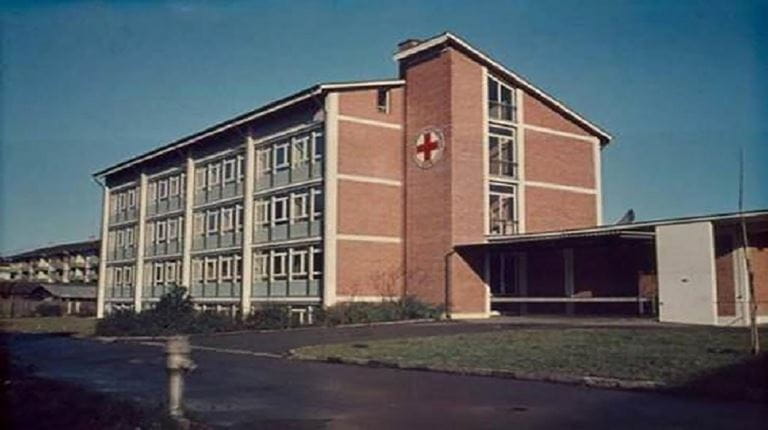Our 100th anniversary video tells you everything you need to know about our promise to our patients.
2021 Operating licence and start of production at CSL Behring Lengnau AG
2018/2019 Engineering runs / process validations for CSL Behring Lengnau AG
2018 CSL Behring Lengnau AG: test operation and qualification
2016 Laying of the foundation stone for the CSL Behring Lengnau AG in Lengnaumoos
2015 CSL Behring AG Bern wins the Swiss Employer Award 2015
In September, CSL Behring AG won prize in the Large Business category. This sensational placing is a great honor for the employees and the Bern Leadership Team.
2015 CSL Behring breaks ground in Lengnau for the new plant
On 30 June 2015, CSL Behring conducted the ground-breaking ceremony for the new "CSL Behring Recombinant Facility AG" (today CSL Behring Lengnau AG), a new plant intended for the manufacture of recombinant coagulating factors in Lengnau. At least 300 new jobs will be created and, over a period of five years, an investment of over 400 million Swiss francs will be made. From 2019, three new recombinant coagulating factors will be produced and marketed around the world for people with hemophilia.
2013 FDA approval for Kcentra® "for urgent warfarin reversal"
The American Food and Drug Administration (FDA) issues a market license for Kcentra to reverse the effects of vitamin K antagonists in adults with acute serious bleeding. In December, Kcentra® was also approved for reversing the effects of vitamin K antagonists on patients who require emergency surgery. CSL Behring markets Kcentra® as Beriplex® or Confidex® in over 25 countries.
2012 CSL receives the 2012 EURORDIS Award
The European Organization for Rare Disorders recognizes CSL Behring’s pioneering work and manufacture of treatments for handling rare and serious illness by presenting the company with the 2012 EURORDIS Award.
2011 The European Commission issues the market license for Hizentra®
The market licence for Hizentra® is issued and is valid in all 29 EU / EFTA member states for the treatment of people who have been diagnosed with primary or secondary immune deficiencies.
2011 FDA issues a license to expand the Hizentra® production plant in Bern
The production capacity for Hizentra® was more than doubled after the FDA gave its approval to expand the modern production plant in Bern.
2011 FDA issues a license for Corifact™, the first and only FXIII concentrate approved in the U.S.
The U.S. Food and Drug Administration (FDA) issued the market license for Corifact™ to treat the congenital Factor XIII (FXIII) deficiency. The congenital FXIII deficiency is a rare and potentially life-threatening coagulation disorder that affects an estimated 1 person in 2 million. Corifact™ is available in 12 countries, including under the trade name Fibrogammin®.
2010 Hizentra®, the first and only 20-percent SCIg is approved by the FDA
The U.S. Food and Drug Administration (FDA) issues the market license for Hizentra®, the first and only 20-percent subcutaneous immunglobulin (SCIg). In the U.S., Hizentra® is used to treat patients with primary immune deficiencies. Hizentra® is also undergoing the registration process for the EU and Switzerland. The immunglobulin product, which is stabilised with L-proline, is ready to use and can be stored at room temperature for its entire shelf life of 30 months, which is more practical for patients and doctors and makes mobility easier.
2009 Berinert® – the first method of treatment for acute HAE attacks in the U.S.
The U.S. Food and Drug Administration (FDA) issued the market license for Berinert® C1 esterase inhibitors, the country’s first and only way to treat acute phases of hereditary angioedema (HAE) in the abdomen or face.
2009 CSL Behring receives the Tell Award for Innovation
CSL Behring was presented with the Swiss government’s Tell Award for the most important investment in innovative technologies in 2008. This award honours CSL Behring’s unusual innovations within highly modern production and the latest protein treatments.
2009 NORD honors CSL Behring with an award for rare disorders
The National Organization for Rare Disorders (NORD) honors CSL Behring for its development and marketing of RiaSTAP®, America’s first and only treatment method for acute blood episodes in patients with a congenital fibrinogen deficiency, a very rare and occasionally fatal blood condition.
2009 CSL Behring donates $2 million to the WFH GAP programme
For the further development of diagnostics and treatment of hemophilia in developing countries, CSL Behring donates, over a three-year period, coagulation factors worth 2 million USD for the Global Alliance for Progress (GAP) programme by the World Federation of Hemophilia (WFH).
2009 CSL Plasma opens highly modern laboratory
ZLB Plasma was renamed CSL Plasma in order to adapt its name to that of the parent company CSL Behring and opened one of the world’s largest and most modern testing laboratories for plasma in Knoxville, TN.
2009 Ig Lab plant approved in Bern (Switzerland)
FDA, EMEA, Swissmedic and TGA issued approval for the highly modern production plant immunoglobulin in Bern (Switzerland).
2009 RiaSTAP™ receives exclusive status as an “orphan drug”
The U.S. Food and Drug Administration (FDA) issues CSL Behring’s product RiaSTAP™, the first approved treatment for acute bleeding episodes in patients with a congenital fibrinogen deficiency, with the exclusive status of an “orphan drug” for the treatment of rare disorders for seven years.
2008 Process for mutual recognition of the approval for Berinert® P completed
Berinert® P was approved in 20 additional countries in Europe. Now, patients with inherited angioedema in these countries can be helped too.
2008 Professor Heimberger Research Award founded
CSL Behring founds a research award in order to honour the achievements of a new generation of specialist in coagulation disorders. The award was named in honor of the former employee of the Behringwerke, and early expert on hemophilia, Dr Norbert Heimberger. During his time at the Behring plants, Dr Heimberger discovered a new method of pasteurizing plasma proteins.
2007 FDA approval for Rhophylac® for ITP in the U.S.
The U.S. Food and Drug Administration approves the treatment of immune thrombocytopenic purpura (ITP) as an additional indication for Rhophylac®.
2007 FDA approval for Privigen®
The U.S. Food and Drug Administration issues a market license for Privigen®, the first proline-stabilized intravenous immunglobulin (IVIg) for the treatment of primary immune deficiency and chronic immune thrombocytopenic purpura.
2007 ZLB Behring becomes CSL Behring
As part of our global adaptation of company names, we become CSL Behring. Our name may have changed, but we remain the same. CSL Behring continues to build on a tradition of innovation to the benefit of patients.
2006 Two Ig formulations available in Canada
With the approval of Sandoglobulin® Liquid NF (IVIg) and Vivaglobin® (subcutaneous Ig), ZLB Behring is the only company to offer patients in Canada with primary immune deficiencies two immunglobulin formulations.
2006 50% volume reduction of Humate-P®
The factor VIII compound Humate-P® is offered in a reduced-volume concentrated solution. The new medicine, in a package size that has been reduced by 50%, does not need to be administered as long and requires less storage space.
2006 Vivaglobin® first SCIG in the U.S.
The polyvalent immunglobulin Vivaglobin® for subcutaneous administration is approved for the U.S. market. This makes it the first subcutaneous immunglobulin treatment approved in the U.S.
2006 Modern production plant for Zemaira® approved by the FDA
Highly automated production system with increased capacity for the production of Zemaira® in Kankakee, Illinois.
2006 Vivaglobin® approved in the United Kingdom
Vivaglobin® is approved in the United Kingdom for the treatment of children and adults with a congenital antibody deficiency syndrome.
2006 High-technology production plant for immunglobulins in Bern
On the grounds of ZLB Behring in Bern, work starts on building a new, highly modern production plant for immunglobulins.
2005 Introduction of Mix2Vial®
ZLB Behring introduces Mix2Vial®n, an alternative feeding system for haemophilia products.
2004 Foundation of ZLB Behring
After the takeover of Aventis Behring by CSL and the merger with ZLB Bioplasma, the company ZLB Behring comes into being.
2004 Mononine® approved by the EMEA
The factor IX concentrate Mononine® is approved by the EMEA for treatment of haemophilia B patients who have to undergo surgery, suffer trauma or experience significant haemorrhaging. ZLB Behring is thus the first company to provide a factor IX compound that is approved for the treatment of these indicators.
2004 Rhophylac® approved in the U.S.
The anti-D immunglobulin Rhophylac is approved for the U.S. market.
2003 Assurance Programme introduced in the U.S.
The Assurance Programme is introduced to ensure that patients who require our recombinant and plasma-based treatments can continue to receive them, even if their private health coverage is interrupted.
2003 Approval of Zemaira® in the U.S.
Zemaira is approved in the U.S. to treat patients with alpha-1 antitrypsin deficiency in the event of clinical evidence of emphysema.
2003 Carimune® NF on the American market
In the U.S. Carimune® NF, the first nanofiltered normal immunglobulin made of human plasma for intravenous use is introduced.
2001 Largest commercial company in plasma collection
Aventis Behring acquires 42 plasma centers from Serologicals, thus founding the world’s largest company for the commercial collection of donor plasma.
2001 Foundation of ZLB Plasma Services
CSL acquires 47 plasma collection centers and laboratory facilities from Nabi Plasma Collection Centers (USA) and founds ZLB Plasma Services.
2000 Foundation of ZLB Bioplasma
CSL takes over the central laboratory for blood donation from the Swiss Red Cross and founds ZLB Bioplasma with its headquarters in Bern.
2000 New formulation of the recombinant factor VIII
Helixate® FS/ Helixate® NexGen (rec. coagulation factor VIII) for the treatment of hemophilia A is produced with sucrose for the first time and is approved in the U.S. and 15 other countries.
1999 First von Willebrand factor in the U.S.
Humate-P® is approved in the U.S. for the treatment of von Willebrand syndrome too – the most common hereditary blood coagulation disorders.
1998 50-million-euro revamp of production plants in Marburg
A 50-million-euro project to revamp the production plants in Marburg is completed successfully.
1996 Introduction of Rhophylac®
Rhophylac®, the first virus-filtered, liquid anti-D immunglobulin for intramuscular and intravenous use, is introduced in Switzerland. Rhophylac® is used as a prophylactic for rhesus sensitisation.
1993 Approval of Helixate® in the U.S.
Helixate® is approved by the FDA as a recombinant coagulation factor VIII for the treatment of haemophilia A.
1990 Introduction of Monoclate®-P
Pasteurisation, an additional virus deactivation step, is introduced for Monoclate®-P, the second generation of Monoclate factor VIII using monoclonal antibody technology.
1988 Japan’s first fibrin adhesive
Beriplast® P is the first fibrin adhesive to arrive on the Japanese market.
1986 Approval for Humate-P® in the U.S.
Humate-P®, the plasma protein concentrate with coagulation factor VIII/von Willebrand factor complex, is approved in the U.S. for the prevention and treatment of haemorrhagic episodes in haemophilia A patients.
1984 First approved IVIg in the U.S.
The polyvalent immunglobulin from ZLB is the first approved IVIg product in the U.S.
1981 First pasteurised factor VIII treatment – the first of its kind in the world
Haemate® P, a plasma product with the coagulation factor VIII/von Willebrand factor complex, is marketed for the first time in Europe to treat haemophilia A patients. This makes it the world’s first pasteurised factor VIII medication.
1979 Introduction of a highly purified IVIg
ZLB and Sandoz AG, Switzerland, bring Sandoglobulin®, the world’s first highly purified immunglobulin for intravenous application, to market.
1970 IV-immunglobulin in Japan for the first time
Gamma-Venin is the first IVIg on the Japanese market.
1962 New fractioning method released
At ZLB, Kistler and Nitschmann develop a new method for plasma fractioning that provides a much better yield of the proteins isolated from the plasma.
1955 Research at the Behring plants discovers alpha-1
The proteinase inhibitor alpha-1 antitrypsin is discovered, purified and characterised by researchers at the Behring plants.
1954 First pasteurised solution made of plasma proteins
ZLB manufactures the first pasteurised solution out of plasma proteins.
1951 ZLB receives permission to manufacture products using blood plasma
The Swiss government empowers ZLB to sell medicine made of blood plasma via the blood donation service of the Swiss Red Cross.
1949 Foundation of ZLB
Under the auspices of the Swiss Red Cross (SRK), Switzerland’s first blood donation service, the Central Laboratory of the Blood Donation Service (Zentrallaboratorium Blutspendedienst SRK (ZLB)) is founded.



